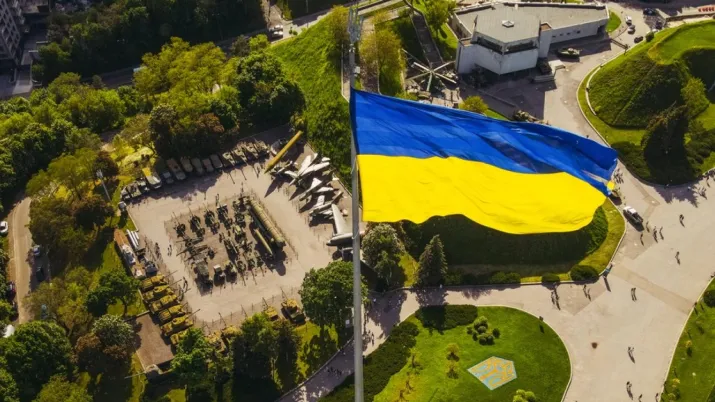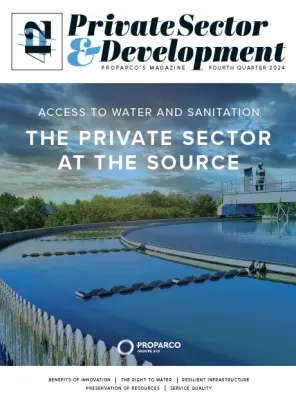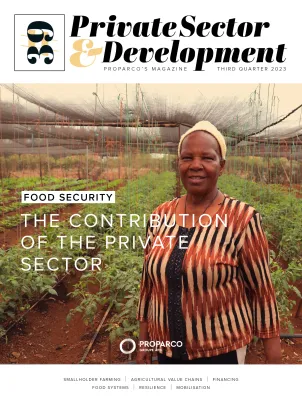Share the page
Journey without Maps
Published on
David Kuijper Directeur général EDFI

Private Sector & Development #43 - European development finance institutions: strategic players in changing times
Proparco is publishing the 43rd edition of its Private Sector & Development magazine, focused on the action of European development finance institutions (DFIs).
Radical uncertainty in geopolitics and geoeconomics is set to increase, along with risks of crises – and the global community’s mitigating capacity is diminished. In a world without a global balance of power, a ‘G-zero world’, Development Finance Institutions (DFIs) are well positioned to buttress Europe’s ability to act cohesively on the global stage to safeguard European values, which overlap with the Sustainable Development Goals.
When British Prime Minister Harold MacMillan was asked what the biggest challenge was for a Prime Minister, he responded: ‘Events, my dear, events’. When radical uncertainty hits, unexpected global and regional events disrupt carefully crafted strategies, slash the value of risk models, and disturb focus. Difficult times await the ‘planners’, while the ‘searchers’ may turn out to be better equipped.
Recently many unforeseen events have unfolded for which politicians felt unprepared, causing unease in organisations. Who could have thought last autumn that a lightning-fast rebel offensive would capture Damascus, ending the Assad regime in Syria and greatly reshuffling the Middle East card deck once again. Meanwhile, an EU historic first: an annulled democratic election amid allegations of Russian interference; a newly elected U.S. Vice-President calling Europe ‘undemocratic’, and the world’s richest person, ‘First Buddy’ to President Trump, openly backing Germany’s radical-right party; North Korea sending troops to Europe; and South Korea surviving an autocoup. Meantime, the US President has threatened Denmark with invading Greenland.
In the coming years, this radical uncertainty in geopolitics and geoeconomics will increase. The global community’s capacity to deal with downside monetary and geopolitical risks has decreased. Hence, societies are more vulnerable to financial and economic crises.
GLOBAL REALIGNMENT SCENARIOS
There are multiple reasons for this vulnerability. First, DFIs global collective ability to act has been weakened by a decline in government capacity. Governments in the three largest global markets United States, China and the European Union – have shown a lack of effective action to mitigate downside risks. This has added to economic uncertainty in the mid to long term and the possibility of a sudden jump in financial market volatility. In all three leading economies, debt has swelled, while productivity lags. This malaise has gone hand in hand with political decline. US and European democracies have been weakened by populism, influencing operations by autocratic powers, and divisiveness in the social media. Popular calls for strong leadership worldwide are a preoccupying sign of institutional weakness. In China also, demographic challenges, economic decoupling/technology bans and over-centralisation have put pressure on the Communist Party governance model, compromising the capacity of government to pursue effective economic policy and reforms.
Concerning too is the ‘beggar-thy-world’ strategy conducted by the two leading economies (US and China): instead of exporting stability, they are exporting disruption. China is exporting overcapacity, and the U.S. under Trump will likely export higher interest rates. In response, other countries will raise protectionist barriers, and financial conditions will tighten. Governments are, to varying degrees, retracting to ‘country-first’ policies, threatening future global output and further contributing to geopolitical and trade tensions.
The EU Global Gateway strategy is leaving its start-up phase, with the ambition to mitigate the consequences of global disruption for Europe and secure vital value chains. While Global Gateway is geostrategic, rather than protectionist, protectionist elements – such as the preference for EU standards and companies – are emerging. Previously, effective global governance would have mitigated the effects of such emerging trends in the leading economies. However, the multilateral system is showing worrying signs of breaking up, especially concerning economic and climate policy coordination. Waning US leadership, the basis of the multilateral system, is providing space for alternative structures. BRICS is an attempt at this.
Increasingly, we are at risk of moving to what Ian Bremmer calls the ‘G-zero world’ –one where no single country or alliance of countries holds the political or economic dominance to coordinate an international agenda and a world order no longer aligned with the global balance of power. To realign the world order with emerging global powers, three possible scenarios are possible: reform the current system and ensure its governance corresponds to geopolitical reality; design new structures; allow for disintegration, and factor in more conflicts and wars. We seem to be on track for the third scenario.
We are in the unique situation where the leader of the dominant global power is advocating for dismantling the very system that it built up to exercise its global power. Large countries such as Mexico, Indonesia, and South Africa do not yet have the ways and means to set up alternative multilateral systems that bring stability.
ENTERING A PERIOD OF TRANSITION
How can DFIs best cope with radical uncertainty? There is no need to drastically change forecasting tools, but rather for greater awareness of the geopolitical contexts in which DFIs operate. Also, resilience and levels of preparedness within DFIs need to be boosted.
DFIs find themselves in a central and visible forward position, vulnerable to crises but also highly relevant for crisis responses, as the war in Ukraine has shown. This frontline position is akin to the position DFIs were in during the Cold War, but with some stark differences: they were in a relatively quiet niche within a stable multilateral system, anchored by the World Bank, IMF, and regional development banks; they were smaller, less pioneering, and therefore less vulnerable to ‘events’ and criticism, as well as being less regulated and therefore less complex organisations.
In 2025, the multilateral system is crumbling, and DFIs are much larger and spread over a wider geography. They are in more sectors than before, and are under scrutiny in this age of social media, affecting their agility and risk appetites. Regulatory frameworks require deep expertise and additional capacity, and there are mounting costs and unprecedented levels of complexity within the organisation and in the investment process. As after the end of the Cold War, DFIs are entering a transition period. Despite the complexity described, European DFIs are arguably in a good base position to navigate this transition. They stand a good chance of achieving sustained growth, based on their performance over the last decade; their investment network in key emerging economies; their robust impact measurement and data systems – which help DFIs respond to transparency demands – and the unique expertise of more than 3500 staff. Making use of this base will require close coordination within and among DFIs. It will also require engagement with shareholders on the capacity of DFIs to be flexible, creative, and pioneering.
DFIs are embarking on a journey without maps. As Forster and Charnoz mention in their November 2023 paper, “the urgency for DFIs to innovate, adapt, and deliver is intensifying”. They argue that, to respond to a rapidly “evolving development landscape”, DFI strategies will need to shift focus. While these currently emphasise optimising operations, a shift is needed to reflect on ‘core purpose, essence, and direction’. DFIs have always functioned against the backdrop of the post-war multilateral system, which is now crumbling. Henceforth, they and their shareholders need to define their role in a ‘G-zero’ scenario. Consequences and measures can be identified at two levels: those in the medium- to long-term for DFIs’ respective markets and for their clients, and those for DFIs’ immediate business continuity.
MEDIUM- TO LONG-TERM CONSEQUENCES
Falling government capacity and a G-zero world would create a more fragmented and inequitable future landscape for development finance. In this scenario, several consequences are possible: Overall, a G-zero world will lead to heightened political risk and unpredictable policy environments. This will be compounded by shareholders shifting their focus to national or regional priorities. In addition, complex prudential and financial regulations and reticent investment partners may make it more difficult for DFIs to invest and take risk. Possible DFI responses include: Localisation will be required due to increased unpredictability and risk. This will involve more engagement with local partners and better local intelligence gathering through local presence and liaising within the local policy and investment arena, as well as with multilateral and diplomatic actors.
Data harmonisation, standardisation and transparency will have an even higher priority, requiring acceleration. This is because perceptions of increased risk and less appetite for the extra costs of impact management can be countered by quality data and transparency. Availability of concessional finance may decrease over time. Government budgets will realign to new global realities, with a rapid increase in defence spending and domestic industry subsidies, to the detriment of international aid budgets. In this scenario, pools of concessional finance may be available only for geostrategic sectors, such as critical raw materials, food security, harbour and transport infrastructure, and digital transformation. To access these funds, many DFIs may need a costly refocus. Possible DFI responses include: A need to actively advocate for a broader vision on geostrategy among policymakers and politicians. This will include emphasising the geostrategic importance of maintaining and scaling-up concessionality in climate finance, renewable energy and the financial sector.
Syndication and mobilisation platforms will be needed, with more deep and structured cooperation with institutional investors and existing platforms (e.g. ILX) that are not dependent on concessional finance. Non-public sources of concessional finance/grant funding – philanthropic foundations, private funds and family offices – will need to be accessed through more deep and structured cooperation.
Over time, a drop in multilateral effectiveness could stall the evolution of global standards, leading to more splintering and divergence of standards and therefore rising compliance costs. Possible DFI responses include: Active engagement with global standard-setting bodies (e.g. IFC, IFRS, and OECD) will be required for the evolution of standards and to ensure their relevance and alignment with DFIs’ investment practices.
The principle of interoperability – intensification of DFIs’ plea for embedding within EU regulatory frameworks with national and international ESG standards, in particular, IFC standards – will be required. This will ensure that global standards are well anchored in national frameworks. Rising compliance costs will be countered by bundling DFI compliance operations, for instance, through joint KYC teams.
CONSEQUENCES FOR DFIs’ IMMEDIATE BUSINESS CONTINUITY
DFIs are experienced in dealing with uncertainty. Nevertheless, the increase in the ‘quantum of uncertainty’, and the increased likelihood of disrupting events, necessitates thought on whether DFI practices and systems can deliver. Are the DFI business strategies ‘sufficiently robust to alternative futures and resilient to unpredictable events’?
A G-zero world with growing radical uncertainty may weaken DFIs’ strategy execution and risk management practices. Conventional risk management relies on historical data to estimate probabilities for the future. Risks in a G-zero world, however, are often novel. How can DFIs prepare for these? The possibilities are: Recalibrating existing strategies to ensure these are sufficient to deal with radical uncertainty. Adaptive, scenario-based strategic planning should be introduced. It should allow for rapid action after unexpected events. A ‘prepared searchers’ and continuous learning culture should be fostered, with the emphasis placed on preparing for any number of possible futures. Building resilience in IT infrastructures and operational guidelines: as DFIs are increasingly involved in geostrategic policy (e.g. Ukraine), the risk of cyber incidents is mounting. In addition, IT infrastructures should be capable of promoting rather than deterring cooperation among DFIs.
STRENGTHS AND PARTNERSHIPS, KEYS TO DFI RESILIENCE
As ‘events’ and more uncertainty will dominate DFI operations more prominently in the years ahead, they will need to be prepared to manage the risks. DFIs will also need to keep sight of the opportunities that uncertainty brings, building on their past strengths and expertise. As business owners know, uncertainty brings new horizons for entrepreneurship and growth. This is no different at the geopolitical level – and no different for DFIs.
At a time of multilateral uncoupling and political decline, DFIs need to rely on their strengths and partnerships more than ever. DFIs are uniquely placed to mitigate the effects of such disintegration and to step into the void that may open up. Their tradition of cooperation needs to be treasured as well as their close links to policymakers through shareholders. Stronger cooperation in the development of joint narratives, mutual support in risk management and the boosting and bundling of resources to fight further cost inefficiencies may be prerequisites for the successful and steady navigation of a world where unexpected events are ubiquitous.
DFIs also play a role in buttressing Europe’s ability to act cohesively on the global stage to forge meaningful partnerships with EMDEs and to safeguard European values, which overlap with the Sustainable Development Goals. DFI prominence as an operational channel also presents a rare opportunity to assist in strengthening Europe’s geostrategic role and to help prevent a protectionist relapse. Finally, as the world order is realigning its balance, DFIs can also play a role in thwarting a meltdown of the transatlantic alliance. There is a common interest among societies on both sides of the North Atlantic to build on efforts to defend multilateralism, democracy, and free market values. EDFI’s recent affiliate partnerships with FinDev Canada and U.S. DFC could prove to be an asset in these efforts.
Author(s)
David Kuijper
Directeur général
EDFI








